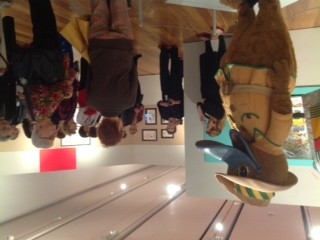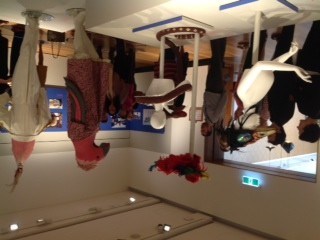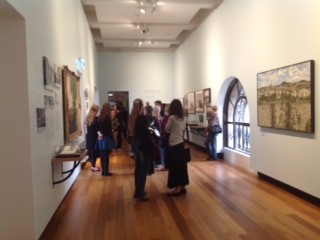
Recently staff from the John Oxley Library spent a rewarding morning investigating three fascinating exhibitions at the reopened Museum of Brisbane on the third floor of Brisbane's splendidly renovated City Hall building.
Our previous visit, just over a year ago, was to the MOB's temporary home in Ann Street whence the Museum, first established in 2003, relocated in 2010 when the City Hall closed to allow for its large scale, three year long restoration project. While the former Ann Street location is dwarfed by any comparison with the Museum's current accommodation (2000 sq metres of museum space, five beautifully designed galleries, tallowwood floors, views of the magnificent clock tower and copper dome) that earlier visit provided some orientation to the Museum's cultural philosophy.
The Museum, in the words of Director Peter Denham, is "part of a living history of the city" and its exhibitions reflect on how the city’s landscapes and social culture continue to evolve over time. The MOB's interest is in social history, in the milestone events which have characterised the city's development and it celebrates not only those landmark events, but the lesser known experiences which are associated with them. At the furthest remove from offering a fossilised history, its quest, according to Peter Denham, is to "uncover unexpected and fascinating stories" attaching to "seemingly ordinary people and places of Brisbane".
This philosophy is masterfully applied to the first of the opening exhibitions, Light Fantastic: Expo 88 Parades Rewired which celebrates the 25th anniversary of the groundbreaking Expo 88 event. Just by way of context, World Expo 88 was held in what is now the South Bank precinct from April 30 to October 30 as part of Australia's 1988 Bicentenary celebrations. The Expo site featured 100 international pavilions and attracted 55 countries who came to showcase their individual cultures. In character it resembled an exciting fun park replete with roving entertainers, concerts, parades, presentations and interactive pavilions. Visitor numbers totalled 15,760,447 over the period, averaging 100,000 per day; ticket sales fetched in $175 million and the cost of the event was estimated at $625 million.
The exhibition's spotlight is on two colourful features which are generally held to have been an enduring legacy of Expo 88, both because they registered indelibly in the memories of most Expo visitors and because they were unprecedented in Australia's history: the Lunchtime and Qantas Light Fantastic Parades. Hugely popular with the crowds, these spectacles took the form of a daily lunchtime and an evening light parade and they involved 19 floats fashioned by individual designers. The MOB exhibition celebrates the creative talent which was responsible for the design of these parades and it anticipates them in an initial display of Expo memorabilia.

Thanks to some generous hospitality on the part of our MOB hosts we had the benefit of the inside story about the origins of the exhibition. We heard that, having decided to celebrate Expo's 25th anniversary, the Museum appealed to the community and in just one week was swamped with Expo memorabilia. The focus on the parades was made possible by the Museum’s access to an archive of drawings from parades producer Mike Mullins who in 1988 assembled an impressive team of float and costume designers, lighting and special effects experts and performers. The Exhibition features design drawings and models, among them a collection of very convincing food models and the iconic Expo echidna which decorated the motorised floats of the Ant's Picnic. (The handmade originals have been ingeniously reproduced for the exhibition via 3D printing and the replicas are a tenth of their original size.) The celebrity cockatoo Major Mitchell, who starred in the lunchtime parades, is a dominant character in the exhibition.
Perhaps the most significant aspect of Expo 88 is the disproportionate influence this relatively brief, spectacular event had on the subsequent development of Brisbane and on its evolution as a modern, sophisticated city. The next exhibition, Panoramas provides some fascinating historical framework for the Expo event and makes a sudden transition in focus from a six month snapshot from the eighties to a span of 150 years in the life of the city.
We were immediately drawn to this excellent photographic exhibition and absorbed by what it revealed about the city's development in the decades between 1860, about the time photography was introduced to Brisbane, and the present day. The intention of each of the panoramic views is to provide physical context for the glimpse of life depicted in a representative decade and to chart the dramatic growth of the city over the 150 year period. The very early views of Brisbane are particularly compelling, revealing as they do a rudimentary settlement ringed by scrub, unpaved dirt roads, horse drawn vehicles, timber houses on stumps, brick chimneys and steep roofed stone churches. If there is such a thing as a "favourite" panorama mine would undoubtedly be the 1870 view with its incredibly charming stone and timber buildings and the seductive old world quality of its vibrant streetscapes.
I was pleased to hear that Panoramas is just the first in a continuing series of exhibitions called Document, each of which seeks to explore how artists and photographers interpret Brisbane's landscape, history and culture. This is in keeping with the Museum's broader interest in the city's identity and in the social and cultural life of its community.

Given that a dominant visual theme in the panoramas is the Brisbane River, there is a logical progression to the next exhibition The River: a History of Brisbane which looks at the city's development and growth from the perspective of the river, tracing its history from early settlement days. The River showcases photographic images, historical and contemporary paintings, models and extracted text from the City of Brisbane's collection of more than 6,000 items.
We were greatly impressed by this wonderful exhibition and more than a little inclined to linger beyond the planned duration of our tour. We did in fact linger an extra ten minutes to view, on a giant screen, a mesmerising short film from award winning director Peter Hegedus which follows the course of the river from its source to the sea in a succession of archetypal images. This is the sort of exhibition which inspires more than one visit and we were happy to learn that it will be open until the end of 2015.
Reflecting on the value of these three fantastic exhibitions, I was struck by how beautifully they complement our own collections here in the John Oxley Library. I was thinking for example of our Panoramic Views of the Expo Site 1985-88 which you can launch from the OneSearch catalogue, of the extensive Noel Pascoe collection of digitised photographs (also available from OneSearch), of the James Maccormick Correspondence, Plans, Drawings and Reports relating to the architecture and establishment of World Expo 88, of the many digitised images (almost 200 of them) and the scores of Expo posters in the collection. The Panoramas exhibition at MOB is very nicely complemented by the Panoramic Queensland exhibition which was held at the State Library between February and July in 2009 and which includes ten brilliant high resolution digitised images entitled Documenting the Growth of Brisbane. And I was thinking in particular of resources which focus on the Brisbane River - not only the many images, plans and charts, early maps, sketchbooks, art works and documentary resources - but the widely acclaimed 2012 Floodlines exhibition which charted both the 2010-11 flood events and those which occurred in 19th Century Brisbane.
As a group of people with an abiding interest in Queensland’s history and culture, it’s fair to say we anticipated the MOB exhibitions with some enthusiasm. Our high expectations were more than met. It was an immensely enjoyable and worthwhile visit and an experience which is highly recommended to anyone with a passing curiosity about our city’s past. The Museum of Brisbane is to be congratulated on its impressive achievement.
Comments
Your email address will not be published.
We welcome relevant, respectful comments.